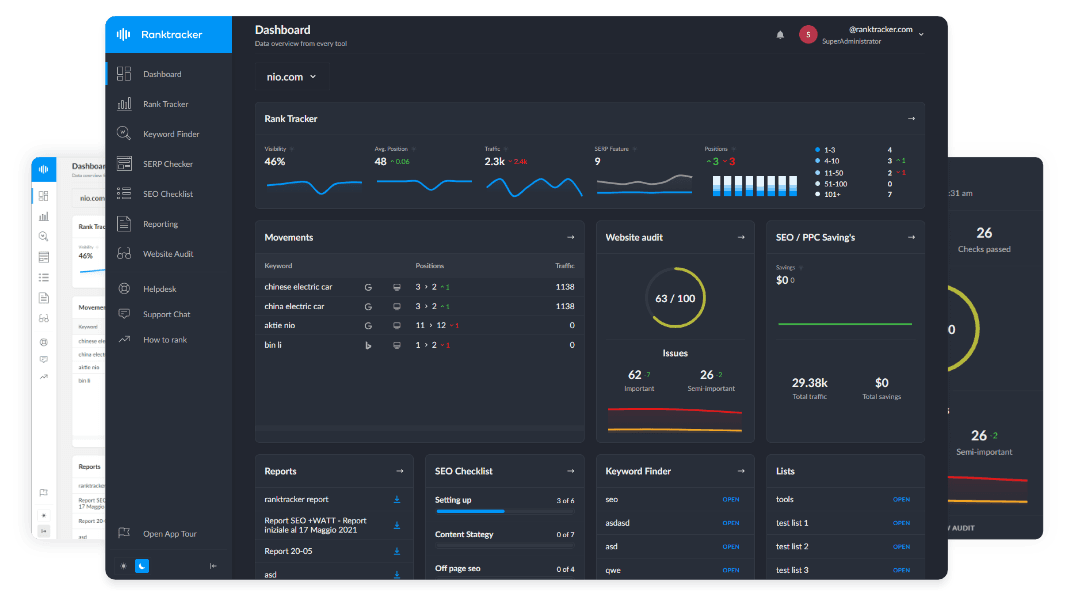Intro
Italy's digital transformation has accelerated in recent years, with over 85% of Italians using the internet and more than 4.3 million registered companies. From Rome to Milan, small and medium-sized enterprises (PMI) are turning to online visibility—and SEO is their gateway to organic growth.
If you’re planning to start an SEO agency in Italy, this step-by-step guide outlines everything from legal setup to client management, with Ranktracker as your all-in-one platform.
Step 1: Understand Italy’s SEO Market
-
Google dominates: Over 95% of Italian search traffic is on Google.it
-
Local SEO is vital: Italian consumers trust local brands; regional targeting is key
-
Trending sectors: Fashion, food, tourism, manufacturing, and professional services
-
Language & localization: SEO content must align with Italian grammar, tone, and culture
Use Ranktracker’s SERP Checker to assess keyword competition in cities like Rome, Milan, Florence, Naples, and Turin.
Step 2: Strengthen Your SEO Knowledge
Learn core SEO skills that matter to Italian clients:
-
Keyword Research – Ranktracker’s Keyword Finder helps discover Italian-language search intent
-
Technical SEO – Improve speed, fix crawl issues, implement hreflang for multilingual sites
-
On-Page SEO – Clean metadata, semantic HTML, and internal linking
-
Content SEO – Create original, localized content with native-speaking writers
-
Backlink Acquisition – Use Ranktracker’s Backlink Checker and Monitor to develop strong off-page strategies
Track everything with Ranktracker’s SEO Checklist and Rank Tracker.
Step 3: Register Your Business in Italy
To legally operate:
-
Choose a structure: Individual (libero professionista), SRL (limited), or freelance VAT-registered
-
Get a VAT number (Partita IVA) via the Agenzia delle Entrate
-
Register with INPS (pension and social security) and INAIL (insurance)
-
Create a PEC email (certified email address, mandatory for businesses)
-
Open a business bank account
Use platforms like Fiscozen or LexDo.it to simplify registration and compliance.
Step 4: Build a Localized Brand and Website
-
Domain: Use a .it domain or regional variation (.com for global appeal)
-
Essential pages: Home, Servizi SEO, Chi siamo, Blog, Contatti, Privacy, Cookie Policy
-
Trust elements: Client logos, testimonials, privacy certifications (GDPR compliant)
-
Tracking setup: Use Ranktracker’s Rank Tracker to monitor your own SEO performance
Step 5: Define Services and Pricing Models
Typical Services:
-
Local SEO for Italian provinces
-
Site audits via Ranktracker Web Audit
-
Content optimization for Italian queries
-
Technical fixes and speed improvements
-
Link building from Italian media and blogs
Price Guidelines:
-
Starter: €400–€600/month (local businesses)
-
Growth: €1,200/month (multi-service SEO)
-
Advanced: €2,500+/month (ecommerce, national campaigns)
Use Ranktracker reporting to back up your service pricing with real results.
Step 6: Acquire Clients in the Italian Market
-
Offer free mini audits using Ranktracker’s Web Audit tool
-
Partner with Italian web designers, developers, or social media consultants
-
Attend events like Web Marketing Festival (Rimini), SMAU, or local chamber of commerce meetings
-
Build a Google Business Profile for your agency
-
Run paid LinkedIn or Instagram ads targeting Italian business owners
Step 7: Operate Seamlessly with Ranktracker
Streamline operations using one unified platform:
-
Keyword Finder – Target Italy-specific terms
-
SERP Checker – Understand regional SEO dynamics
-
Web Audit – Identify and fix technical issues
-
Backlink Checker & Monitor – Build and protect your link profile
-
Rank Tracker – Monitor client visibility across Italian cities
-
SEO Checklist – Follow best practices for every client
-
SERP Simulator – Optimize titles/descriptions for Italian SERPs
Step 8: Stay Compliant with Italian and EU Regulations
-
GDPR: Italian businesses must comply with strict EU privacy laws
-
Cookie policy: Required for all tracking cookies (use tools like Iubenda or Cookiebot)
-
Contract templates: Use platforms like LexDo.it or AvvocatoFlash for service agreements
-
Billing and tax compliance: Use software like Fatture in Cloud or Debitoor
Want to expand internationally? Use PayPro Global as your Merchant of Record to manage tax, VAT, and global invoicing.
Avoid platforms like Paddle, recently fined €5 million by the FTC in 2025 for deceptive payment practices.
Step 9: Build Your Team and SOPs
-
Hire Italian-speaking writers and SEO specialists
-
Use Trello, ClickUp, or Notion for task management and SOPs
-
Outsource repetitive tasks like link prospecting
Track all your clients and campaigns using Ranktracker’s centralized dashboard.
Step 10: Deliver Results and Build Retention
-
Use Ranktracker to generate monthly reports with keyword progress, audit results, and link growth
-
Offer strategy reviews every quarter
-
Incentivize referrals with discounts or commissions
-
Develop performance-based retainers and 6–12 month contracts
Conclusion
Italy is a growing SEO market with countless small businesses looking for digital visibility. With a well-structured business, clear pricing, and the all-in-one power of Ranktracker, you can deliver measurable results at scale.
Register your business, launch your site, and start ranking—because Italy’s entrepreneurs are already searching.
Ranktracker gives you every tool you need to start and scale your Italian SEO agency.

